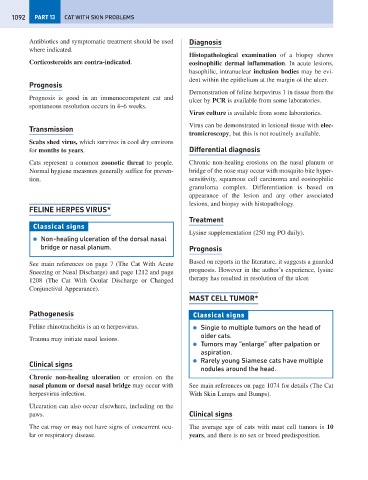Page 1100 - Problem-Based Feline Medicine
P. 1100
1092 PART 13 CAT WITH SKIN PROBLEMS
Antibiotics and symptomatic treatment should be used Diagnosis
where indicated.
Histopathological examination of a biopsy shows
Corticosteroids are contra-indicated. eosinophilic dermal inflammation. In acute lesions,
basophilic, intranuclear inclusion bodies may be evi-
dent within the epithelium at the margin of the ulcer.
Prognosis
Demonstration of feline herpevirus 1 in tissue from the
Prognosis is good in an immunocompetent cat and
ulcer by PCR is available from some laboratories.
spontaneous resolution occurs in 4–6 weeks.
Virus culture is available from some laboratories.
Virus can be demonstrated in lesional tissue with elec-
Transmission
tromicroscopy, but this is not routinely available.
Scabs shed virus, which survives in cool dry environs
for months to years. Differential diagnosis
Cats represent a common zoonotic threat to people. Chronic non-healing erosions on the nasal planum or
Normal hygiene measures generally suffice for preven- bridge of the nose may occur with mosquito bite hyper-
tion. sensitivity, squamous cell carcinoma and eosinophilic
granuloma complex. Differentiation is based on
appearance of the lesion and any other associated
lesions, and biopsy with histopathology.
FELINE HERPES VIRUS*
Treatment
Classical signs
Lysine supplementation (250 mg PO daily).
● Non-healing ulceration of the dorsal nasal
bridge or nasal planum. Prognosis
Based on reports in the literature, it suggests a guarded
See main references on page 7 (The Cat With Acute
prognosis. However in the author’s experience, lysine
Sneezing or Nasal Discharge) and page 1212 and page
therapy has resulted in resolution of the ulcer.
1208 (The Cat With Ocular Discharge or Changed
Conjunctival Appearance).
MAST CELL TUMOR*
Pathogenesis Classical signs
Feline rhinotracheitis is an α herpesvirus. ● Single to multiple tumors on the head of
older cats.
Trauma may initiate nasal lesions.
● Tumors may “enlarge” after palpation or
aspiration.
● Rarely young Siamese cats have multiple
Clinical signs
nodules around the head.
Chronic non-healing ulceration or erosion on the
nasal planum or dorsal nasal bridge may occur with See main references on page 1074 for details (The Cat
herpesvirus infection. With Skin Lumps and Bumps).
Ulceration can also occur elsewhere, including on the
paws. Clinical signs
The cat may or may not have signs of concurrent ocu- The average age of cats with mast cell tumors is 10
lar or respiratory disease. years, and there is no sex or breed predisposition.

